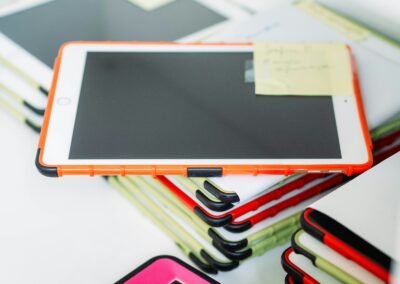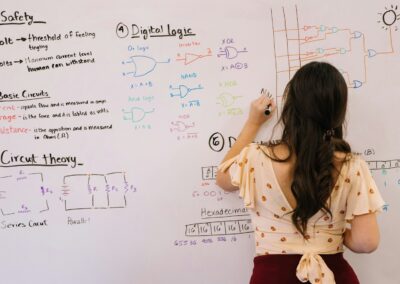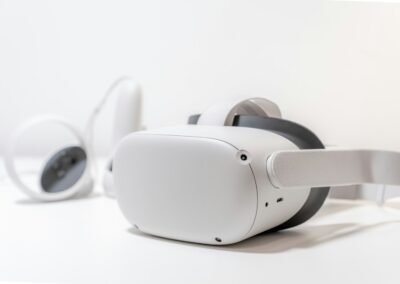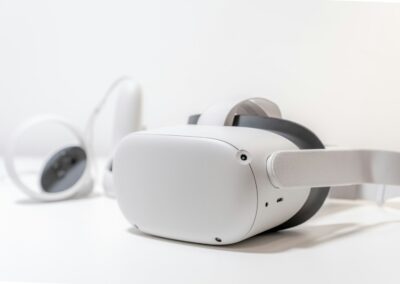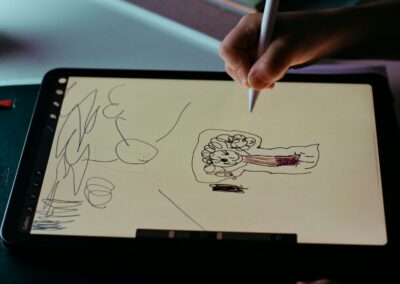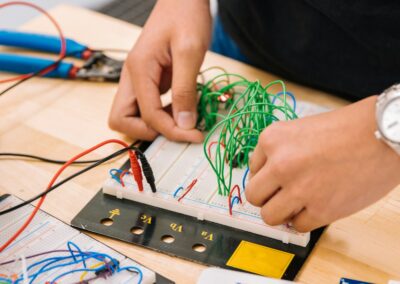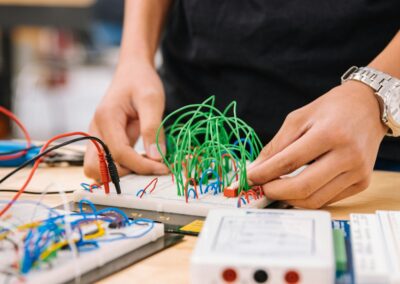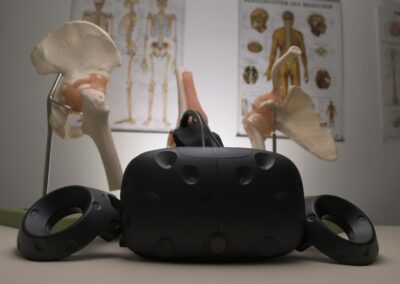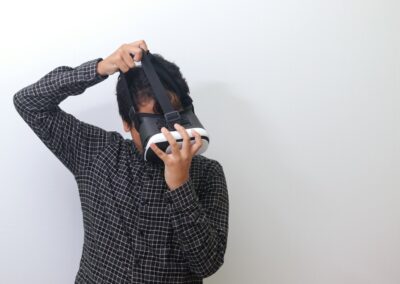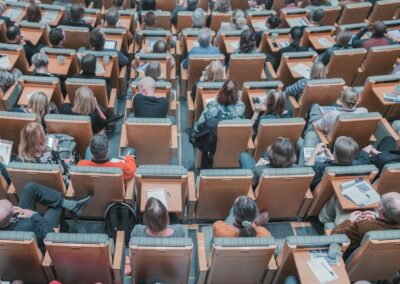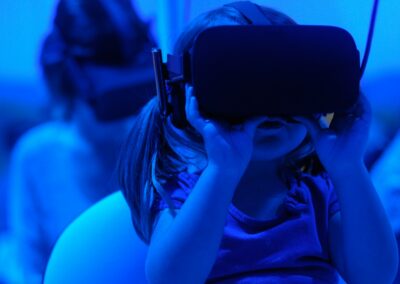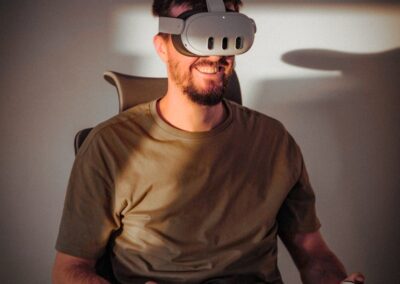The Transformative Role of AR and VR in Virtual Learning
The Emergence of Augmented and Virtual Reality in Education
The future of virtual learning is poised to be revolutionized by augmented reality (AR) and virtual reality (VR), technologies that create highly immersive and interactive educational environments. These technologies are not just enhancing traditional learning methods but are fundamentally changing the way education is delivered. In regions such as Saudi Arabia and the UAE, where innovation in education is a priority, AR and VR are rapidly being integrated into educational systems to provide students with unparalleled learning experiences.
Augmented reality overlays digital information onto the real world, allowing students to interact with virtual objects in their physical environment. This technology is particularly effective in subjects like science and history, where students can explore complex concepts and historical events in a more tangible and engaging manner. For example, in a biology class, students can use AR to examine the human anatomy in 3D, gaining a deeper understanding of the subject matter.
Virtual reality, on the other hand, immerses students in a completely virtual environment, enabling them to experience scenarios that would be impossible or impractical in the real world. VR can transport students to ancient civilizations, outer space, or inside a chemical reaction, providing them with experiential learning opportunities that enhance comprehension and retention. The adoption of VR in classrooms in Riyadh and Dubai is a testament to its effectiveness in creating engaging and impactful educational experiences.
Technological Foundations and Innovations
The successful integration of AR and VR in education relies heavily on robust technological foundations. High-speed internet, powerful computing devices, and advanced software applications are essential components that enable the seamless operation of AR and VR platforms. In Saudi Arabia and the UAE, significant investments are being made to develop the necessary infrastructure to support these technologies.
Artificial Intelligence (AI) plays a crucial role in enhancing AR and VR experiences. AI algorithms can adapt the content to suit the learning pace and style of individual students, providing personalized learning experiences. For instance, AI can analyze a student’s performance in real-time and adjust the difficulty level of a VR simulation to ensure optimal learning. This level of customization ensures that each student can benefit fully from the immersive learning environment.
The Metaverse, a collective virtual shared space, also holds great potential for virtual learning. Within the Metaverse, students can interact with peers and instructors from around the world, participate in collaborative projects, and access a vast array of educational resources. This interconnected virtual space can break down geographical barriers, making high-quality education accessible to students in Saudi Arabia, the UAE, and beyond.
Implementing AR and VR in Saudi Arabia and UAE Classrooms
Implementing AR and VR in classrooms involves a strategic approach to ensure successful adoption and maximum impact. Educational institutions in Saudi Arabia and the UAE are partnering with technology providers to deploy state-of-the-art AR and VR solutions. These partnerships are crucial in developing customized applications that cater to the specific needs of the curriculum and student demographics.
Teacher training is an essential component of the implementation process. Educators need to be proficient in using AR and VR technologies to effectively integrate them into their teaching practices. Training programs are being designed to equip teachers with the skills to create immersive lesson plans, manage virtual environments, and provide real-time feedback to students. By empowering teachers with the necessary knowledge and tools, educational institutions can ensure that AR and VR are utilized to their full potential.
Access to AR and VR technologies is also a critical factor. Educational institutions are investing in affordable and scalable solutions to ensure that all students have the opportunity to benefit from these advanced learning tools. In Riyadh and Dubai, initiatives are being launched to provide schools with the necessary hardware and software, ensuring that the adoption of AR and VR is inclusive and widespread.
Impact of AR and VR on Student Engagement and Learning Outcomes
Enhancing Student Engagement
AR and VR have a profound impact on student engagement by making learning more interactive and enjoyable. These technologies capture students’ attention and keep them actively involved in the learning process. Interactive elements, such as virtual experiments, simulations, and 3D models, make learning fun and memorable. In Saudi Arabia and the UAE, where student engagement is a top priority, AR and VR are proving to be invaluable tools in achieving this goal.
The immersive nature of AR and VR allows students to experience lessons in a way that traditional methods cannot. For example, instead of reading about historical events, students can use VR to virtually travel back in time and witness these events firsthand. This experiential learning approach fosters a deeper connection to the subject matter and enhances understanding and retention.
Furthermore, AR and VR enable collaborative learning, where students can work together in virtual environments to solve problems and complete projects. This collaborative aspect not only enhances engagement but also develops critical thinking, communication, and teamwork skills. By interacting with peers in a virtual space, students can gain diverse perspectives and learn to work effectively in a team.
Improving Learning Outcomes
The personalized learning experiences offered by AR and VR significantly improve learning outcomes. AI-driven analytics provide insights into student performance, allowing educators to tailor their teaching strategies to meet individual needs. This data-driven approach ensures that each student receives the support they need to succeed, leading to better academic performance.
AR and VR also facilitate experiential learning, which is particularly beneficial for subjects that require practical, hands-on learning. For example, in science classes, students can conduct virtual experiments that would be too dangerous or expensive to perform in a real lab. This hands-on approach helps students grasp complex concepts and apply their knowledge in real-world scenarios.
The continuous assessment capabilities of AR and VR platforms enable teachers to monitor student progress and provide timely feedback. Regular quizzes, interactive activities, and virtual assessments help identify learning gaps early on and allow for prompt intervention. This continuous feedback loop ensures that students stay on track and achieve their learning goals.
Success Stories of AR and VR in Education
Several success stories from Saudi Arabia and the UAE highlight the positive impact of AR and VR on student engagement and learning outcomes. In Riyadh, a leading international school implemented an AR-based curriculum for science and history classes. The school reported a significant increase in student participation and academic performance, particularly in STEM subjects. Students were able to conduct virtual experiments, participate in interactive simulations, and collaborate with peers from around the world, enhancing their learning experience.
In Dubai, a prominent educational institution adopted VR to create immersive learning environments for subjects like geography and biology. The institution utilized VR to take students on virtual field trips to different parts of the world and explore ecosystems and geographical features. As a result, student engagement remained high, and the institution reported improved learning outcomes, with students achieving higher grades and demonstrating a better understanding of the curriculum.
These case studies demonstrate the transformative potential of AR and VR in education. By leveraging advanced technologies and innovative teaching methods, educational institutions in Saudi Arabia and the UAE can provide students with engaging and effective learning experiences, preparing them for success in the modern world.
Conclusion
The future of virtual learning is bright, with AR and VR technologies playing a pivotal role in creating immersive and interactive educational environments. In Saudi Arabia and the UAE, where education is a top priority, these technologies are transforming the educational landscape and enhancing student engagement and learning outcomes. By integrating AR and VR into classrooms, educational institutions can provide students with personalized and experiential learning experiences that cater to their diverse needs.
The success stories from Riyadh and Dubai highlight the positive impact of AR and VR on student engagement and academic performance. By providing flexible and accessible learning solutions, AR and VR can help bridge the gap between traditional and modern education, ensuring that all students have the opportunity to succeed. As technology continues to evolve, the potential of AR and VR in education will only increase, offering new and exciting possibilities for students in Saudi Arabia, the UAE, and beyond.
—
#AugmentedReality #VirtualReality #ImmersiveLearning #InteractiveEducation #SaudiArabia #UAE #Riyadh #Dubai #ArtificialIntelligence #Blockchain #Metaverse #ExecutiveCoaching #GenerativeAI #ModernTechnology #BusinessSuccess #LeadershipSkills #ManagementSkills #ProjectManagement


